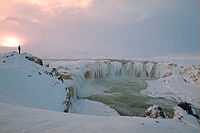Goðafoss




The Goðafoss (Icelandic: waterfall of the gods or waterfall of the goði) is one of the most spectacular waterfalls in Iceland. It is located in the Mývatn district of North-Central Iceland at the beginning of the Sprengisandur highland road. The water of the river Skjálfandafljót falls from a height of 12 meters over a width of 30 meters.
In the year 999 or 1000 the Lawspeaker Þorgeir Ljósvetningagoði made Christianity the official religion of Iceland. After his conversion it is said that upon returning from the Alþingi, Þorgeir threw his statues of the Norse gods into the waterfall. Þorgeir's story is preserved in Ari Þorgilsson's Íslendingabók.
A window in the Cathedral of Akureyri (Akureyrarkirkja) illustrates this story.
MS Goðafoss, an Icelandic ship named after the waterfall, was carrying both freight and passengers. It was sunk by a German U-Boat in World War II, resulting in great loss of lives.
See also
- List of waterfalls
- Waterfalls of Iceland
- Christianisation of Iceland
-

Fosshóll restaurant at the turnoff to Goðafoss
-

Ring Road bridge over Skjálfandafljót river
-
Goðafoss
External links
Edge of the Arctic- Places to See (English)
Velkomin á Norðausturland: Áhugaverðir staðir (aka Edge of the Arctic- Places to See in Icelandic)
Panoramic virtual tour of Godafoss
Coordinates: 65°40′48″N 17°32′24″W / 65.68000°N 17.54000°W
